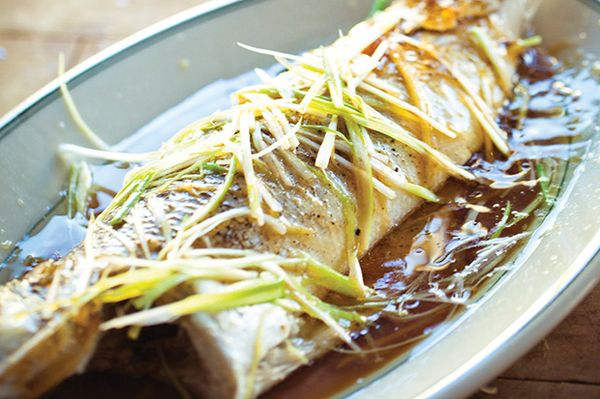
Steamed Whole Fish with Ginger, Scallions, and Soy

Ingredients
Seafood
Produce
Condiments
Baking & Spices
Oils & Vinegars
Beer, Wine & Liquor
Other
Found on epicurious.com
Description
This is a simple way to prepare whole fish, yet one that few Western cooks have mastered. In the Vietnamese culture, a properly steamed fish is a benchmark for chefs, and those who can't do it right are considered to be bad cooks. A perfectly steamed fish has flesh that is just cooked at the bone, never dry. Typically, whole fish are not served with the liquid in which it was steamed, which is too fishy tasting, and any sauce is added at the end, after the fish has been cooked. In this classic Chinese preparation, the fish is topped with scallions, cilantro and ginger, then doused with hot oil, which releases the flavor of the aromatics into the flesh of the fish.
Ingredients
Directions
Nutrition

| Title: | Steamed Whole Fish with Ginger, Scallions, and Soy |
| Descrition: | This is a simple way to prepare whole fish, yet one that few Western cooks have mastered. In the Vietnamese culture, a properly steamed fish is a benchmark for chefs, and those who can't do it right are considered to be bad cooks. A perfectly steamed fish has flesh that is just cooked at the bone, never dry. Typically, whole fish are not served with the liquid in which it was steamed, which is too fishy tasting, and any sauce is added at the end, after the fish has been cooked. In this classic Chinese preparation, the fish is topped with scallions, cilantro and ginger, then doused with hot oil, which releases the flavor of the aromatics into the flesh of the fish. |
Steamed Whole Fish with Ginger, Scallions, and Soy
Seafood
Produce
Condiments
Baking & Spices
Oils & Vinegars
Beer, Wine & Liquor
Other
The first person this recipe

Found on epicurious.com
Epicurious
Steamed Whole Fish with Ginger, Scallions, and Soy
This is a simple way to prepare whole fish, yet one that few Western cooks have mastered. In the Vietnamese culture, a properly steamed fish is a benchmark for chefs, and those who can't do it right are considered to be bad cooks. A perfectly steamed fish has flesh that is just cooked at the bone, never dry. Typically, whole fish are not served with the liquid in which it was steamed, which is too fishy tasting, and any sauce is added at the end, after the fish has been cooked. In this classic Chinese preparation, the fish is topped with scallions, cilantro and ginger, then doused with hot oil, which releases the flavor of the aromatics into the flesh of the fish.